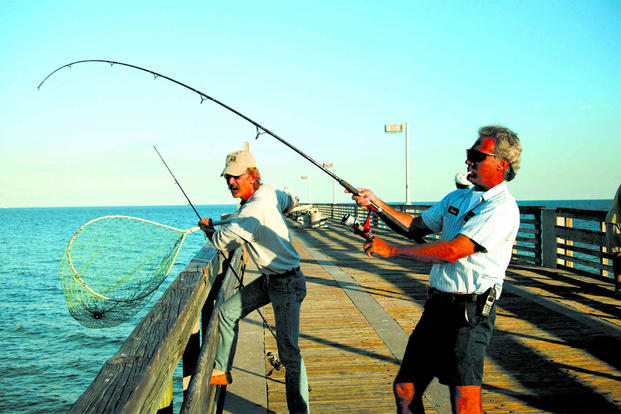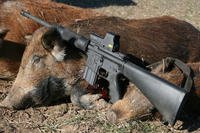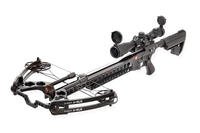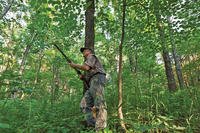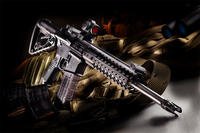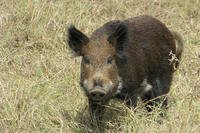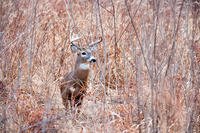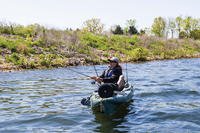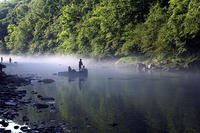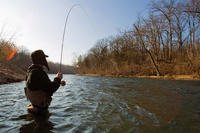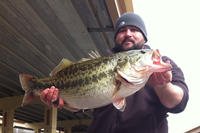Outstanding marine fishing is available from coastal piers. Everything from croakers, whiting, snook, redfish, sheepshead, flounder and striped bass are regularly caught by pier fishermen. Even bigger species more commonly targeted by boat anglers are caught by "plank walkers." For example, cobia, king mackerel and a wide variety of hefty sharks are regularly taken from Southern piers jutting into the Atlantic or Gulf of Mexico.
Not all the tackle and accessory fishing equipment listed here is needed by every pier angler. But there's gear here for anglers targeting everything from pompano to tarpon. Pick and choose what you need for what you're fishing for. Most of this equipment is available where coastal fishing tackle is sold. Ours came from Bass Pro Shops.
Reels on Wheels Jr. Utility Cart:
Toting all your gear to the end of a long pier is a lot easier with a well-made cart. This rugged model is large enough to pull all your equipment, plus it has vertical holders for carrying multiple rods, and a cutting board.
Rod-Reel Combos
Light: Pflueger Infusion 7-foot IM-8 graphite spinning rod, coupled with a Pflueger five-ball-bearing reel (holds 120 yards of 10-pound-test) is ideal for everything from sheepshead and whiting, to pompano, croakers and other medium-size fish.
Medium: Shimano's Calcutta B four-ball-bearing bait-casting reel (5-to-1 gear ratio; holds 160 yards of 20-pound-test line), on a 7 ½-foot Bass Pro Shops Offshore Angler Inshore Extreme Casting Rod is made to order for redfish, snook, seatrout, flounder, striped bass and other mid-size marine targets.
Heavy: When big, tough fish such as cobia, king mackerel and jack crevalle are on tap, a tough Fin-Nor Offshore spinning outfit is perfect. The 7-foot heavy action graphite-fiberglass composite rod is suitable for 30-pound-test line, and the Fin-Nor machined aluminum reel with multi-stack drag holds 375 yards of 30-pound-test monofilament (at least double that capacity if spooled with thin braided line).
Extra Heavy: Jumbo sharks and tarpon require heavy gear. Bass Pro Shops Offshore Angler Stand-Up is perfect for lines testing 50 to 80 pounds. The one-piece machined-aluminum reel frame is sturdy enough to handle the big boys, and carries 475 yards of 50-pound-test line.The 6-foot graphite composite rod features Fuji guides and a rugged AFTCO roller striper guide and tip.
Line
Braid: Braided line is great for pier fishing since it's tough and extremely abrasion resistant. PowerPro braid is one of the most popular versions, and is available in a wide range of tests.
Monofilament: Mono is still in wide use, and one of the most popular brands in recent years is Shakespeare's "Cajun Line." It's inexpensive, and comes in bulk spools of all popular tests.
Fluorocarbon (leaders): Although "Seaguar Fluorocarbon" looks like monofilament line, it doesn't stretch as much, and is almost invisible in even clear water. Short leaders of 2 to 5 feet long are sufficient and economical, and can be used with braid or monofilament.
Wire (leaders): Ready-made wire leaders are convenient and quick to use, and for much pier fishing they're great. Use wire just thick enough for the targeted species: thin wire and hooks for mackerel and bluefish, heavier wire and hooks for king mackerel and sharks.
Making your own wire leaders is easy, but it's often best to do it before going fishing.Still, having some wire available is a good move should mackerel or bluefish suddenly show around a pier.Malin wire is well-known, and its non-glare coffee color is almost invisible to fish.
Hooks
Pier fishermen need a wide assortment of bait hooks.Bigger hooks are needed for bigger baits, and fish. Smaller hooks for dead shrimp and other mini-baits for species like croakers and whiting. A good assortment pack of saltwater hooks is the way to go to keep hooks orderly and rust-free in a plastic container.
Sinkers
Like hooks, a large assortment of style and weight sinkers is needed by pier jockeys. Strong currents, tides, depths and casting distance dictate lots of lead weight needs.An assortment pack is smart.You'll need some split-shots and egg sinkers; plus pyramid-style leads for holding bottom on sandbars.
Sinker Slides
This often overlooked accessory makes it fast and easy for changing different size and weight sinkers according to fishing conditions.
Swivels
Swivels are a mainstay of fishing, especially for pier anglers. Used to prevent line twist, they also connect line to leaders, sinkers to line, and lures to leaders. Match the size to the fishing line, and be sure to use tough enough swivels for heavy fish like king mackerel and cobia. Swivels are not expensive, and it's smart to buy large assortment packs to cover all needs.
Floats
Ready-made commercial floats are needed by most pier fishermen to keep baits and lures off bottom, and to indicate strikes.
Making your own float is a snap with the use of balloons. Inflate the balloon to the size needed, then tie it off and attach it to the fishing line. Balloons tend to burst when taken underwater by fish, so they don't interfere in the ensuing fight. The biodegradable balloons shown are environmentally safe.
Lures
A wide assortment of artificial lures are used by pier fishermen in order to cover the entire water column — from the surface to the bottom.
Jigs are one of the most important lures in a pier angler's tackle bag because they can be used to catch almost anything that swims. Small, lightweight and stubby pompano jigs are specialized, but work on a wide variety of fish, such as Spanish mackerel and seatrout. Grub jigs in all sizes catch seatrout to cobia.
Carry jigs in a wide variety of sizes, colors and weights; have some nylon-body models, some with bucktails and others with soft-plastic tails. Scented grubs and other soft-plastics made by Berkley (Gulp!) are deadly in salt water, and can be fished effectively off a jig head.
Jig-head assortment packs are a good idea, as the size of hook and weight of head needed for any given day of fishing might vary depending on the species of fish available.
Spoons flash and dance during a retrieve and can be cast far when distance is important. Some spoons are weedless when cover is a concern. Have a selection of heavy and light spoons, in various sizes and weights. Gold and silver models work well, but multi-hued spoons work, too. Johnson, Hopkins, Acme and other companies make excellent marine spoons.
Sinking Plugs such as those ones made by MirrOlure and Bagley are needed often when striking fish refuse to come topside. Many such plugs run 2 to 8 feet deep, and imitate mullet, menhaden and other important marine prey species.
Topwater plugs produce heart-pounding strikes from a wide variety of species, including snook, seatrout and cobia. Such surface lures must be of sturdy construction, and capable of long-distant casts. Good ones like the Heddon "Zara Spook," Bagley "Finger Mullet" and MirrOlure "Top Dog" have been popular and productive for many years. Newcomers such as the Heddon Saltwater Spit'n Image and the Saltwater Pop n Image are killers for bluefish, too.
Soft-plastic shrimp lures are excellent, and better than most plastic jig grub tails for some species of fish, such as seatrout, snook and, at times, redfish. The D.O.A. Shrimp has a storied reputation.
Hook File
A sharp hook for baits, lures, jigs and other artificials is critical. Just a few strokes with a quality carbon-steel file will improve hookset success.
Cooler (Soft-Sided)
An ice chest will keep drinks cool and dead bait like shrimp fresh. Also, if you catch some fish you should put them on ice right away. A soft-sided cooler is "crushable," thus more compact to tote and use.
Pier Gaff
After you hook a fish you've got to get it up to the boardwalk or deck. With light line, and a wiggling quarry, a large hook (gaff) on a heavy rope is the best and easiest way of lifting a fish out of the brine.
Pliers, Side cutter, Crimper
Carbon-steel fishing pliers will do about everything a pier fisherman wants; from removing hooks from fish, to crimping sinkers, to cutting wire.
Tackle Bag With Multiple Plastic Boxes
A good-size tackle bag can carry a bunch of gear, including jackets and pliers; but mostly it must carry lures, hooks, sinkers and other necessary fishing gear. The best tackle bags, have plenty of space for multiple plastic tackle boxes, which are good for protecting lures and other gear from salt water. Each box can be dedicated to a specific type of tackle, including plugs, jigs, sinkers, etc.
Cast Net
If you want to catch live bait quickly, nothing beats a good cast net, and Calusa makes some of the best.
Drop Bait Net
Sometimes bait hovers close to pilings and the best way to get it is with a drop net. A drop net also can be used to help land small fish you catch, too.
Fighting Belt
Hook a big fish from a pier and the ensuing fight might last for a half-hour or more. Working a rod at your mid-section for that time, with a tough fish on the line, can take its toll on your mid-section. A lightweight fighting belt is the solution.
Fillet Knife Kit
A good knife kit for pier fishermen has several knives for cleaning fish and cutting bait, plus handy sissors for cutting line, a scale for weighing fish, a cutting board, and gloves for protecting hands while using tools.
Rainsuit
The weather might be great when you leave for the pier, but that can change in a hurry. Even in summer a wind-whipped rain is cold, and a rainsuit keeps you warm.
Sunglasses
Don't leave home without eye protection, and buy the best glasses you can afford. Besides allowing anglers to view below the surface to spot fish and bait, sunglasses also protect the eyes from the sun's damaging ultraviolet rays and wayward casts from nearby anglers.
Hat
A good-quality hat protects you from the sun and rain, and keeps you warm or cool, depending on the weather.
Pants (zip-off legs)
Pier fisherman aren't slaves to fashion, but they're smart when it comes to keeping cool. A number of companies offer pants with zip-off lower legs for those cool, breezy mornings; or when your legs have had enough sun.
Shirt
Lightweight and cool shirts are recommended, especially those that provide extra protection from the harmful effects of the sun. A long-sleeve model protects forearms from sun, wind and rain, but rolls up for cooling off.
Shoes
Wise fishermen on the boardwalk have comfortable foot coverings to protect against sun, wayward hooks, and the occasional dropped catfish. For cool comfort, Crocs are hard to beat for fishing, and they're virtually impervious to anything wet and slimy; plus, they're easy to keep clean.
Sunscreen
Those who don't use waterproof sunscreen in abundance are likely to regret it one day when they visit a dermatologist. Spray-on Bull Frog SPF 36 is excellent.
Sun Gloves
The backs of the hands are subject to severe damage from UV rays. Lightweight sun gloves such as these from Dr. Shade are the cool answer to a hot problem.
Insect Repellent
Sand flies, yellow or deer flies, house flies and even the common mosquito can drive you nuts on a pier. Repel 100 is all DEET and thwarts bugs fast. Careful handling it around some fishing products, however, as it can damage plastic handles and fishing line.
